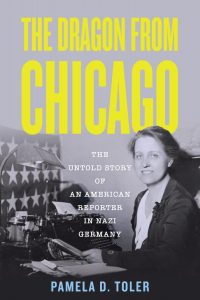Kathryn Cravens: The Flying Reporter
And speaking of women reporters and aviation, as I believe we were, allow me to introduce you to Kathryn Cochran Cravens (1898-1991), “The Flying Reporter.”
Cravens did not set out to become a reporter. In 1919, she went to Hollywood with the goal of becoming an actress. She began her acting career working in silent movies for Fox Films, which was a major player in the motion picture industry at the time. (Fox later merged with 20th Century Pictures to become 20th Century Fox, but I digress.) (1) In 1922, she married Rutherford Rector Cravens. (They divorced in 1937.) Even after her marriage, she worked in silent movies, stock theater companies, and radio theater throughout the 1920s.
In the early 1930s, Cravens’ career took a new direction. She had been working on a women’s program in St. Louis, when the station gave her the opportunity to do a 15-minute daily news program called “News Through a Woman’s Eyes.” (2) Instead of limiting herself to the classic “who, what, where, when and why” of newspaper reporting, she specialized in asking her subjects how they felt about the topic at hand. In 1936, when CBS picked up the show, Cravens and the program moved to New York and her career took off. CBS broadcast her program nationwide, making her one of the first women news commentators heard “coast to coast”. (3) Her show was so popular that it took four secretaries to handled the fan mail.
In 1937, she took to the air in a different way. (Whether this is related to her divorce that year is unclear to me.) She was an early promoter of the commercial air travel, before it was common. (4) As a result, airline companies offered Cravens free air fare in exchange for making air travel more visible. She traveled throughout the country in pursuit of stories, logging more than 100,000 miles as the “Flying Reporter.” During this period, she also produced a syndicated column, titled “Thru a Woman’s Eyes.”(5)
Toward the end of World War II, Cravens became an accredited war correspondent for WOL, in Washington, D.C. Her shortwave reports were titled—what else?—“Europe Through a Woman’s Eyes.” She was one of the first reporters to broadcast from Berlin after the Allied victory in 1945. Among other things, she broadcast live interviews with displaced persons who had relatives in the United States. (6) She covered the Potsdam conference,(7) the Nuremberg trials, and the post-war elections in the Balkans..
After the war, she reported from 22 countries for the Cowles Broadcasting Company and the Mutual Broadcasting system. She also published a novel, Pursuit of Gentlemen. Sources say it is a fictionalized version of her life, but that cover makes me wonder.
(1)The early motion picture industry seems to be tracking me down lately. Hmmm.
(2) Women often found their way into reporting hard news through “the woman’s angle.”
(3) Mary Margaret McBride ran her a close second.
(4) Air travel was expensive and still uncomfortable., even after the introduction of “sky girls” to tend to passengers. Though most Americans were fascinated by aviation, getting on a plane to go from point A to point B was a bird of a different feather.
(5) This is known in modern publishing as building your brand.
(6) Sigrid Schultz also tracked down European relatives for people back home. Instead of broadcasting interviews, she wrote personal notes to their families telling them what she had found.
(7) The Soviets arrested Cravens because she entered the post-war conference site before Truman, Stalin, and Churchill arrived, which was seen as compromising security. After her release, she was suspended from broadcasting for 72 hours.
My publisher is giving away 25 copies of The Dragon From Chicago on Goodreads. You can sign up here through July 4. Good luck!








